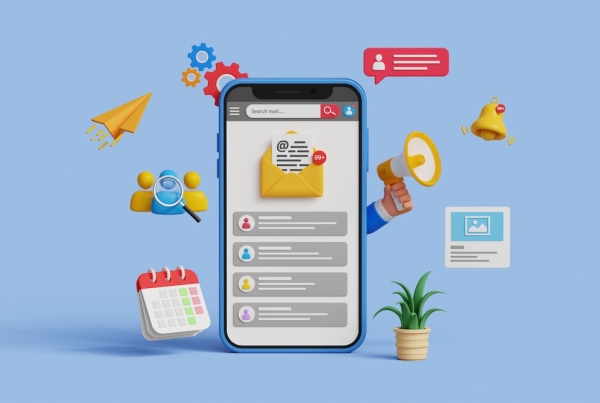In the B2B space, decision-makers rely on evidence before making a purchase and case studies offer the proof they need. Their significance lies in showcasing real-world success stories that demonstrate value and help businesses understand how your solution can solve their challenges. But how can you strategically leverage case studies to attract high-quality B2B leads?
In this guide, we’ll explore how to craft, position, and promote case studies to turn them into powerful lead generation tools. We’ll also break down key elements using a real-world example from hubTGI, a leading technology group that helped the Ontario Mining Association (OMA) right-size their technology to support a remote workforce.
Why Case Studies Are Essential for B2B Lead Generation
Case studies are the perfect middle-of-funnel content. During this stage, prospecting customers are actively evaluating their options, comparing vendors and assessing which solutions fit their needs. In essence, a case study bridges the gap between top-of-funnel awareness content and bottom-of-funnel content by providing tangible proof of how your solution has helped businesses overcome relatable challenges and achieve measurable results.
Consider hubTGI’s case study with the Ontario Mining Association (OMA). Instead of leading with product features, it opens by addressing common pain points that resonate with their target audience including remote workforce challenges, IT security concerns, and operational inefficiencies. Leading with the customer’s real-world struggles helps capture audience attention and make the content relatable.
But an effective case study is more than a success story; it’s a strategic investment that provides proof of success, builds credibility, and gives potential leads the confidence they need to move forward with your business.
Essential Elements for Lead Generation
Crafting a compelling case study that hooks your audience is not enough to convert them as high-quality leads. Rather, focus on creating a story that persuades, engages, and builds trust with the reader. Your content should highlight relevant business challenges, showcase data-driven results, and detail strategic solutions that resonate with prospecting leads. Here are key elements to include:
Clear Problem Statement
Establish relevance with your audience by highlighting specific challenges your case study aimed to resolve. In the OMA study, hubTGI broke down distinct challenges the organization was experiencing, enabling readers to self-identify with the situation and encouraging them to read further. Here are challenges that align with hubTGI’s audience:
- Overspending on unnecessary equipment
- Increasing IT requirements without in-house expertise
- Inaccessible paper-based files
- Cybersecurity vulnerabilities
Quantifiable Results
Backing up your work with statistics and concrete outcomes can transform your case study from a story into a compelling business solution. While you’re not subject to disclose profit metrics, the results of your case study should be specific and meaningful to your audience. Some key business impacts highlighted in the OMA study include:
- Cost savings through right-sized equipment
- Increased staff productivity
- Enhanced operational agility
- Improved data security
Strategic Solutions
In presenting your featured clients’ solutions, emphasize the strategy behind the product or service offered. In the OMA case study, hubtTGI describes how right-sizing their office technology eliminated unnecessary spending and energy consumption. And, by implementing ADVANCE2000 Help Desk, hubTGI increased the organization’s productivity and minimized downtime.
By clearly aligning your solution to measurable business outcomes, your case study will reinforce the value of your offering, positioning your company as a reliable and trustworthy partner.
Authentic Client Voice
Human emotion is one of the strongest tools to use in B2B marketing. Leverage your audience’s emotional connection to their business challenges by adding direct quotes from the client. Here’s a quote from the OMA case study:
“We go into the office and our Xerox machine is working, the security is there, and I don’t have to devote time to fixing things”. – Kathy Downs
Showcasing the client’s voice gives your reader the opportunity to personally connect to business challenges and find value in your products or services.
Crafting a Compelling Case Study
Now that you understand the key elements of a case study that attract high-quality leads, structuring the breadth of information in a way that ensures clarity and maximizes impact is essential. A well-organized case study not only tells a success story but also nurtures potential leads through the buyer’s journey. Here’s how each stage contributes to lead generation:
1. Setting the Stage
Establishing context is the first step in any compelling case study. This includes describing the client’s industry, company size, and unique challenges. In this stage, potential leads recognize this story as their own, making them feel connected to the case and encouraged to read further.
 2. Highlighting Pain Points
2. Highlighting Pain Points
This section articulates the specific challenges that hold the business back, building up a sense of urgency and emotional connection in the reader. If a potential lead sees their struggles mirrored in the case study, then they are more likely to engage with your company’s solutions.
Example: The OMA case study highlighted common technology challenges faced by remote workers, including:
- Overspending on an oversized printer they no longer needed.
- IT issues beyond their internal capabilities.
- Security risks due to remote work.
- Inefficient workflows tied to paper-based documents.
3. How Your Product or Service Helped
Now is your chance to promote how your business addresses the client’s pain points in a way that emphasizes strategy over features. Potential leads want to know how your product or service can solve specific issues, rather than the specs that make it innovative or on trend. Use this as an opportunity to make a lasting impact by explaining why each step was taken and how it aligned with the client’s long-term goals.
Example: The OMA case study details each step taken to address the client’s technology challenges and how each solution targeted specific business goals.
4. Demonstrating Tangible Benefits
The final stage is where you validate your solution with measurable results. Leverage data, client testimonials, and before-and-after comparisons to make your case more persuasive. The goal here is to establish credibility with proof, reduce hesitation, and encourage potential leads to take the next step.
Example: The OMA case study highlights five key benefits of working with hubTGI, backed by measurable results. It also features a personal testimonial that emphasizes the real-world impact of hubTGI’s solutions on their business operations and technology.
Positioning Case Studies for Lead Generation
Imagine this: you worked tirelessly compiling data, writing copy, and ensuring all key elements and structure are optimized for your case study. Now, how do you use it to generate B2B leads?
You’ll need a strategic approach that maximizes visibility, engagement, and impact. Here’s how to do it:
Make Case Studies Easily Accessible
You want your audience to find your case study with ease and capture their interest immediately. Here’s how to make sure your case study stands out:
- On Your Website: Feature case studies in a dedicated area of your website for easy navigation – think ‘Success Stories’ or ‘Case Studies’ section.
- Search Engine Optimization: Use relevant keywords in headlines and meta descriptions to attract organic search traffic.
- PDFs: Offer a PDF version of your case study to visitors, but require them to provide their email to access it for lead generation.
Repurpose Across Marketing Channels
Your case study isn’t a one-and-done project. Rather, leverage the multiple marketing channels at your disposal and repurpose it to engage with different audience segments. Channels you can leverage include:
- Blog Content: Write an in-depth blog (like this one!) analyzing the success story.
- Social Media: Share key statistics, customer testimonials, and short-form success stories across your social platforms.
- Webinars & Events: Use case studies as real-world proof in webinars or client presentations to build credibility.
- Email Campaigns: Include case study snippets in lead generation sequences.
Use Case Studies in the Sales Process
The magic of case studies is their role in the sales process. These targeted success stories give your team first-hand proof of capability to address common industry challenges. Here’s how your sales team can leverage case studies:
- Presentation Decks: Include case studies in sales decks to reinforce your pitch with concrete examples.
- Outreach and Follow-Ups: Use your success stories to build a connection with new prospects and open the door for conversation.
What’s Next?
Case studies are one of the most powerful tools in B2B marketing, enabling businesses to establish credibility, provide social proof, and help potential leads see how your products or services drive real value. When you learn how to structure and promote them strategically and effectively, you can begin to attract high-quality leads and convert them into customers. Need help creating impactful case studies for your business? Reach out to our creative marketing team to learn how we can help showcase your success stories and generate more leads.
About IN2communications
IN2communications is an award-winning digital marketing and web design agency helping hundreds of B2B organizations create awareness, boost consideration rates and generate sales leads.
Our awesome team provides experienced expertise in the following areas: Creative Strategy, B2B Campaigns, Web Development, Video Production, Social Media, Paid Advertising, SEO, Email Campaigns, Blogging, Presentations, Webinars and remarkable Content Creation.








